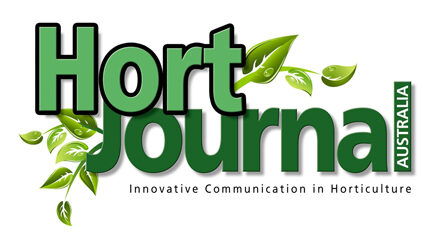
Time anchors a regenerative landscape
By Gabrielle Stannus
How many young landscape architects can say that they have worked on a project for ten years? Heidi Mikulic can, and she says it was time well spent. Heidi started on the Stonehill Gully and Escarpment Regeneration project in 2014, around the same time that she joined Thompson Hay Landscape Architects, the design practice undertaking this work for the site’s developer, Devine Pty Ltd. This project recently received two awards from the Australian Institute of Landscape Architects (AILA) Victorian chapter; the Award of Excellence Winner (Land Management) and Landscape Architecture Award Winner (Infrastructure). Heidi has learnt a great deal about natural bush regeneration working on this project over the last decade, and she kindly shared her time and knowledge with me.
Heidi says that the AILA awards reflected a team effort which included Melbourne Water, the Moorabool Shire Council, Balance Enviro Solutions, Resolution Property Group and other partners. ‘We were very surprised to receive the Award of Excellence. However, looking back, this was quite a unique project,’ says Heidi of the Stonehill Gully and Escarpment Regeneration work. This ten-hectare site in the upper Werribee catchment within the Moorabool Shire Council, northwest of metropolitan Melbourne, is in an area currently undergoing extensive residential development.
‘We were bought in as landscape architects to address the development plan overlay (DPO). There were some very strong environmental considerations as part of that DPO because this site sits above the escarpment of the Werribee River and so it has a direct impact on the river and the escarpment. Essentially our brief was to treat the stormwater runoff from the roofs and roads in this new development, whilst also protecting the escarpment from erosion.”
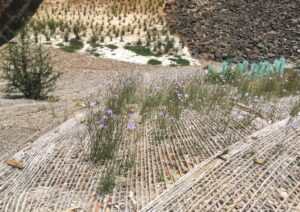
Weed control
Heidi says that work initially began on this site to control the many weeds found there, including the very invasive peppercorn (Schinus molle), African boxthorn (Lycium ferocissimum) and prickly pear (Opuntia stricta). ‘It was not totally intentional, but the way the project worked out, we started doing weed control about three or four years before the site was eventually planted on the escarpment. The wetland embankments were similar. Undertaking that weed control benefited the site and the project greatly, having that extra time to prepare it for planting. Often this type of work happens in only a few months. That is not enough time, especially on a site like this.
‘The Werribee and Lerderderg Rivers through Bacchus Marsh are absolutely choked with peppercorns. These trees would have been planted in the sixties to stabilise the banks from erosion. The best way of managing and eradicating these weeds was to treat the larger trees such as the peppercorns in situ. The landscape contractors, Balance Enviro Solutions, drilled and filled them with a glyphosate-based non-selective herbicide. The dead trees were retained to provide erosion control while the new indigenous vegetation had a chance to establish. It would have been practically impossible to remove these weeds because the site’s steep slopes prevent machinery access. The boxthorn was cut and burnt on site.’
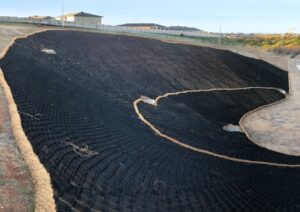
Slope stabilisation
After controlling the weeds, the planting commenced in different stages, but not before slope stabilisation works were undertaken with expertise provided by Axiom Consulting Engineers (civil design) and Douglas Partners (geotech). ‘We had to meet certain standards for Melbourne Water on the embankments around the ponds. They were very steep. It was cut back as part of the civil engineering with very steep grades. Because there was no topsoil there, we had to lay geocell, a type of web that is spread out on the site and then filled up with topsoil. The geocell prevents soil particles moving laterally. We then put mulch on top of the geocell, followed by jute mesh to hold everything in place, and then planting. That was the most expensive treatment in this project versus spot spraying and mulching plants at quite a low density on other areas of the escarpment.’
‘As part of our initial site analysis and assessment, which included a natural and cultural heritage assessments by Ecology and Heritage Partners and Australian Cultural Heritage Management, we mapped the different types of conditions on the site. Some areas of the escarpment had highly weathered basalt rock, so they were quite rocky. These areas were harbouring indigenous flora and fauna. We noticed there was a greater diversity of plants there already than other areas of the site. So that became a special zone. The area immediately adjoining the development was highly disturbed escarpment, and the underlying soil needed to be treated differently. It was fully mulched, jute mesh laid down and then planted out densely.
‘Whereas in other areas, because there was already existing planting and regeneration, the planting densities were much lower. We did not mulch those areas in full. In the steeper, undisturbed yet quite bare areas, we used jute mesh to stabilise the soil, which also controlled weeds and then allowed natural regeneration to occur. There were also several gullies down the escarpment. There is a different plant mix in the gullies, with species that will thrive with more moisture and will grow in a more sheltered location.’
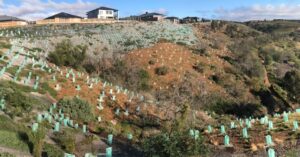
Planting
The limited indigenous vegetation remaining on site was struggling to survive given the competition it faced not only from weeds but also damage from rabbits. When it came to plant selection, Heidi says that the project team wanted to replicate the mix of indigenous tree canopy, and shrub and ground layers that you would have in the typical ecological vegetation class (EVC) here.
‘The site is mapped as Victorian Volcanic Plain EVC 55, which is Plains Grassy Woodland. However, those EVCs are not absolute. You need to ground-truth them. There were some river red gums (Eucalyptus camaldulensis) on the site, not so much on the escarpment, and some native grasses as well. Overall, I would say the site was more of a Rocky Chenopod Woodland EVC given the number of salt bushes in the understorey and some prominent buloke (Allocasuarina luehmannii) throughout,’ says Heidi. Other interesting indigenous plants that Heidi found on site included sweet bursaria (Bursaria spinosa), turkey bush (Eremophila deserti) and the Bacchus Marsh wattle (Acacia rostriformis).
The zone-specific approach to ecological restoration taken here means that existing indigenous plants were retained, adding to the site’s biodiversity. Whilst guided by Melbourne Water’s design standards, Heidi thought it was important to go beyond their plant lists: ‘Every site is different. You need to keep in mind what the project outcomes are. I could have used the EVC 55 as a baseline for plant selection. However, I did not think it would have met the requirements of the brief. Sometimes, those requirements are written into planning permits, and it feels very restrictive. At the end of the day, it came down to what is best for this site? What is best for the plants, the animals, and the people?’
Balance Enviro Solutions grew most of the plants for this project from locally sourced seed and cuttings. A small number of plants were sourced from Ballarat Wild Plants and Western Plains Flora. Tall trees include Eucalyptus leucoxylon (yellow gum), E. melliodora (yellow box), E. polyanthemos (red box), E. tricarpa (red ironbark) and E. viminalis subsp. viminalis (manna gum). Acacia implexa (lightwood) and A. mearnsii (black wattle) feature in the small tree and large shrub layer, supported by the Bacchus Marsh wattle, buloke, Allocasuarina verticillata (drooping sheoak) and other shrubs. A range of medium to small shrubs, climbers, tussocks and groundcovers fill out the understorey including several saltbushes. ‘In late winter to spring, when this place bursts into flower, it is just amazing. It is all yellow and pink, especially with the inland pigface (Carpobrotus modestus). It is quite beautiful,’ says Heidi.
Informal project monitoring shows that this approach is helping to attract fauna. One of Heidi’s favourite moments on site occurred when she accompanied council officer on the final completion walk. ‘We were walking along a rocky section part of the escarpment. I looked up and there was a little eagle (Hieraaetus morphnoides) hovering above us. This is why we do what we do,’ says Heidi. No doubt this predator has its eyes on the frogs, lizards and small birds that are likely to be calling the new wetlands habitat home.

Fragrant saltbush
Over the years, Heidi has grown to like the saltbush on site, with one species becoming her new favourite plant. ‘I live in Bacchus Marsh. When I first moved there, I thought “these fragrant salt bushes really stink!”. On a hot summer’s day, they smell a little like dead flies. Then someone explained to me that this plant’s common name, fragrant saltbush, comes from their flowers, which have a pleasant fragrance. You must be there at the right time to spot them, and now I have grown to love the smell of the leaves as well.’
Rhagodia parabolica (now Chenopodium parabolicum) is a rare plant in Victoria, and it is listed as Vulnerable under that state’s Flora and Fauna Guarantee Act 1988 Threatened List. Heidi tells me that this saltbush is locally common in the gullies of the Werribee River and the Lerderderg River, and even more so now it has been planted extensively as part of this project.
‘The fragrant saltbush is a very versatile plant. It does well with extra moisture, whilst it also tolerates quite dry conditions. Like many indigenous plants, it becomes dormant during dry conditions. Since the last summer, which was very dry, I have seen how this plant can bounce back after rain. This plant also attracts insects and butterflies and is fire tolerant,’ says Heidi, the latter an important consideration given the proximity of this site to the new residential development above it. Its edible berries and leaves feed the local wildlife, and some nurseries in our industry claim the latter are safe for human consumption too. I have yet to test that myself!
Protect existing vegetation
During this project, Heidi has gained a great deal of experience in natural bush regeneration, and as I said earlier, it is lucky for us that she has a generous nature when it comes to sharing her knowledge of what works in the long-term. Akin to the Bradley method, Heidi’s approach to landscape design on environmentally sensitive sites is to keep the best of what is left and then regenerate what is already there. This is especially important for those plants not yet commonly cultivated. ‘We found slightly more plant diversity in amongst the rocks on the escarpment, including the necklace fern (Asplenium flabellifolium). I would not normally include these plants on my proposed planting list because they are very difficult to propagate and source in quantities for landscaping,’ says Heidi.
Plan timing
Many regeneration projects are strictly timed to fit into short-term political cycles such as a local government’s annual budget process, or state or federal government triennial grants. Such funding cycles do not always allow for appropriate site preparation and ongoing maintenance and monitoring. Heidi says that this project was very different in this regard, with long-term support provided by Devine (the developer), Melbourne Water and the Moorabool Shire Council. ‘The timing on this project was so important. It was good to have that time to prepare the site and plant at the right time. So many projects get boxed into a short timeframe, with a very short window for planting,’ Heidi explains.
Take seasonal conditions into consideration when planting
With our changing climate bringing less predictable weather patterns, Heidi reminds us that we need to adopt a more flexible approach to determining planting dates. ‘I see a lot of plant failures, especially in Bacchus Marsh,’ Heidi continues, ‘There is a very small planting window, particularly for revegetation planting. I would not plant anything earlier than the end of April or later than August in Bacchus March, and that would depend on a particular season. Even this year, now (mid-June) would be a good time to start planting because it has just been so dry.’
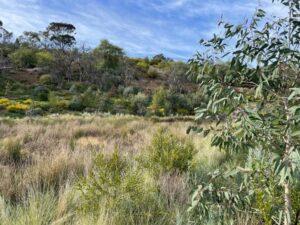
Continuity of care
Judicious plant selection, factoring in site conditions including climate, can reduce plant loss and the need for maintenance. However, as we know, care does not stop once the plants are in the ground. ‘We have designed this landscape in a way that it should be a self-sustaining system once it is established. However, it still requires monitoring and potentially weed control and replanting. It will need continued care. We cannot just set and forget these projects. I think we need to have that approach as caretakers,’ Heidi concludes.
Heidi and the team involved in the Stonehill Gully and Escarpment Regeneration show us how long-term planning makes a real difference to a project, but do not just take my word for it! To conclude, I leave you with the following citation from the AILA jury commending this work:
‘The result shows that the country can be revived with will, skill and ongoing commitment. Care is forever (my emphasis). The jury commends the thinking applied and the remarkable detail and knowledge of the design team. Stone Hill Gully will be a best-practice reference for design standards, method and knowledge’1.
References
1. AILA Awards and Competitions. (n.d.). Stonehill Gully and Escarpment Regeneration. Retrieved July 3, 2025, from https://aila.awardsplatform.com/gallery/QwLkBzjJ/dLVvYxzd
Gabrielle Stannus
Inwardout Studio
M: 0400 431 277
E: gabrielle@inwardoutstudio.com
